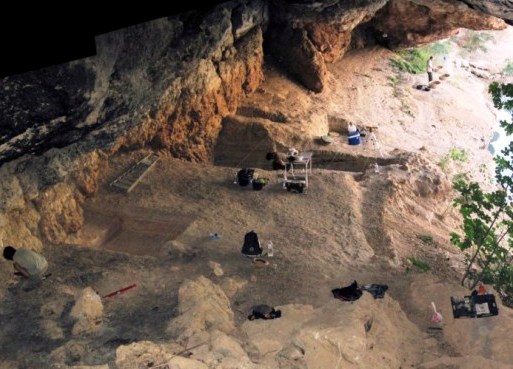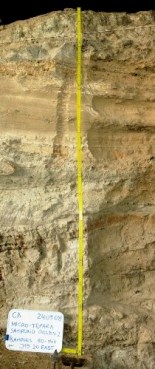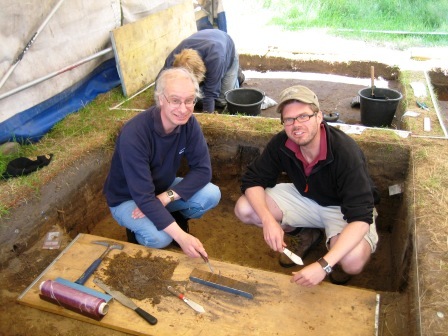News
November 2008
WP-3 Fieldwork in Flanders, Belgium
Rupert Housley
In November WP-3 extended its geographical coverage by sampling three open-air localities in north and east Belgium. In collaboration with Marijn Van Gils & Marc De Bie (Flemish Heritage Institute), Etienne Paulisson (K.U. Leuven), and Ferdi Geerts (Museum De Kolonie, Lommel) the sites of Lommel Maatheide, Arendonk De Liereman and Opgrimbie were sampled for tephra analysis and OSL. Previous investigations at Lommel and Arendonk had revealed stratified sequences of aeolian coversand and Allerød organic horizons with Federmessergruppen lithics. At Opgrimbie no such tools have, so far, been found however the site does preserve a good dune and pedogenic sequence for the Lateglacial, including a bleached Usselo surface with charcoal.

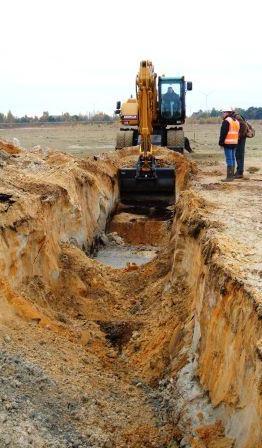
(Left): the present-day heath landscape of Lommel; the area has changed much since the Lategacial due to polluting industrial activity, past erosion of the sandy soil and dumping. At the time of habitation a sandy ridge to the north would have overlooked a shallow fen to the south. (Right): excavation of a trench at the fen-margin in advance of sampling for tephra
October 2008
Caldera-forming eruptions - Campi Flegrei and Ischia, Italy
Martin Menzies
Giovanni Orsi and Lucia Civetta (INGV Osservatorio Vesuviano Naples) are RESET associates on the major marker tephras produced during Plinian and phreato-Plinian caldera-forming eruptions centred on the Campi Flegrei and Ischia calderas, southern Italy. The Ischia caldera formed some 55 ka ago with the eruption of the Tufo verde tephra. The Campi Flegrei resurgent, nested caldera [230 km2] formed in the last 40 ka from two major caldera-forming eruptions that deposited the Campanian Ignimbrite [39.3 ka] and the Neapolitan Yellow Tuff [15 ka] (CI & NYT)]. Detailed volcanostratigraphic work by Giovanni Orsi and colleagues were used as a basis for sample selection, including recent work with Richard Brown (Open University, UK). RESET geochemical results will be integrated with the recent geochemical work of Ilenia Arienzo, Sonja Pabst, Lucia Civetta and Gerhard Worner.
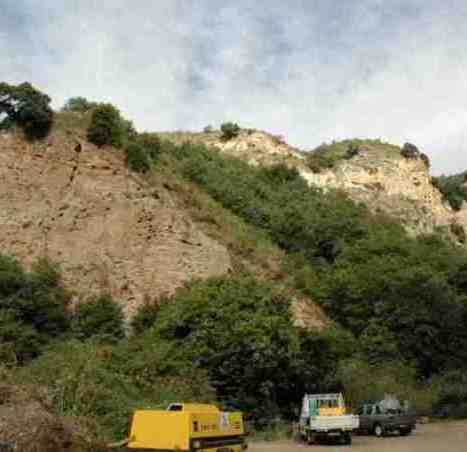

The CI pyroclastic current(s) moved from Campi Flegrei across the Campanian Plain and the Bay of Naples producing 200 km3 of fall and flow deposits and affecting an area of 30,000 km2 with ignimbrite deposition. The magnitude and dispersal of the proximal CI eruption is apparent in trenches we dug 1000 metres up in the Apennines where a metre of CI is exposed (with similar deposition on the southern side of the 1000 m high Sorrento Peninsula). Studies indicate that the CI pyroclastic flow was an expanded, turbulent and decompressing flow fuelled by a vesicle rich magma which can be seen as highly inflated pumice fall at Mondragone. Within the Campi Flegrei caldera and the city of Naples classic CI-NYT exposures are accessible in the Verdoline Valley and Trefola. In the Verdoline Valley the CI (Piperno & Breccia Museo) defines the caldera edge, unconformably overlain by volcanic units (Tufi Biancastri) and eventually the NYT (photo, left). The Trefola Quarry section is significant because of its size and state of preservation, as the caldera floor is a fruit producing area. The volcanostratigraphy covers 15-60 ka revealing that, whilst the eruption of the CI and NYT are important, significant eruptions took place in the 20 ka prior to the formation of the CI caldera, and between the CI and NYT. The NYT eruption and caldera collapse was the second major event emitting 40 km3 over 1000 km2. Given its magmatic complexity the NYT was sampled at several locations.
Located off the coast of Naples is the island of Ischia which has been volcanically and tectonically active for the last 150 ka, uplifted by 900 metres in the last 30 ka. Early in its volcanic history dome building and associated pyroclastic flows deposited tephras in marine (eastern Mediterranean) and lacustrine cores (Lago Grande di Monticchio). This preceded the caldera-forming eruption which began with the Tufo Verde or Monte Epomeo Green Tuff (MEGT) [55 ka] (photo, right) and continued with other significant eruptions. Resurgent magmatism has triggered the present volcanic and tectonic activity (10 ka - AD 1302).
WP-1 Fieldwork in Spain
Dustin White
The first leg of WP-1 fieldwork to sample for distal tephras at key Middle-Upper Palaeolithic sites in Iberia was recently completed by Dustin White and colleagues João Zilhão (University of Bristol) and Diego Angelucci (CENIEH, Burgos) at the site of Cueva Anton (located within the municipality of Mula in the Murcia region of southeastern Spain).
Within this rockshelter fine-resolution fluvial sediments have accumulated which contain a rich record of vertebrate remains and lithic assemblages dating to the late Mousterian Industry. Detailed study of site stratigraphy was followed by systematic (consecutive 2-cm interval) column sampling to document the potential presence of tephras at the site. WP-1 fieldwork in southern Iberia will continue in winter 2009 with sampling trips planned at several sites along the Spanish Mediterranean and in central Portugal.
September 2008
WP-4 Fieldwork in Santorini
Emma Tomlinson
Continuing the ongoing fieldwork to collect European tephras, Emma Tomlinson recently visited the Greek island of Santorini with Dr Vikki Martin (University of Durham). Santorini is famous for the caldera eruption of 3600 BP, which led to the abandonment of a large Minoan settlement, and covered the island in 60 meters of white airfall, surge and pyroclastic deposits. However it is the older eruptions spanning ~100 to 10 ka (Cape Riva, Upper Scoriae 2, Upper Scoriae 1, Vourvolous, Middle Pumice and Cape Thera) that are of interest to RESET. Sampling on Santorini is made easy by excellent outcrop in the numerous large quarries (removing the Minoan deposits for cement manufacture) and the steep caldera rim.
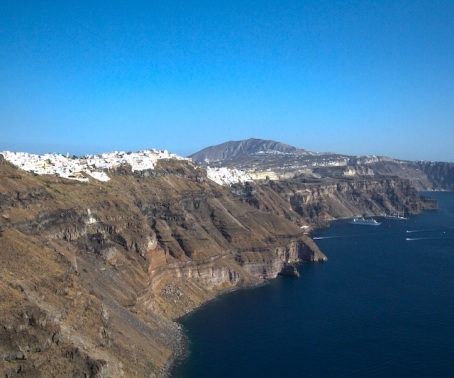

August 2008
WP-3 Fieldwork in Germany, part 2
Rupert Housley and Victoria Cullen
A month after the previously reported trip to Germany WP-3 undertook a second and much more extended fieldwork visit to sample four open-air and two cave sites for tephra. The first locality visited was Oldendorf FStNr. 52 (& 69), an open-air sandy locality on the edge of a former lake / peat bog in Gde Stadt Zeven, Ldkr. Rotenburg (Wümme), Lower Saxony. Under investigation by Klaus Gerken, excavations have revealed a lithic assemblage including arch-backed points and large tanged points of Lateglacial Federmesser form. In addition to sampling the archaeological deposits for tephra and OSL, WP-3 also sampled the nearby lake / peat bog (known as Schünsmoor) using seven 30 cm tins. The second open-air site to be visited, Weitsche - again in Lower Saxony, is situated in Ldkr. Lüchow-Dannenberg on a tributary of the River Elbe. The site has been under investigation by Stephan Veil and Klaus Breest since 1991 and their excavations have revealed a Federmesser / arch-backed point industry believed to date from the early Allerød interstadial. There is also extensive evidence for amber working in the form of waste debris from the site.
The third locality visited was the site of Langefeld-Bad Kösen in Burgenlandkreis, Saxony-Anhalt. This was again an open-air site situated in arable land on a terrace above the River Saale close to the large well-known Magdalenian horse-hunting site of Saaleck. Langefeld was first discovered by Dietrich Mania during field walking but in 2008 was being trial-trenched by Jürgen Richter and Thorsten Uthmeier. A single 40 cm tin was used to sample the levels below the modern plough soil for tephra from where the Magdalenian lithics were coming.


The fourth and final open-air site visited was Wesseling-Eichholz, situated south of the city of Köln. This rescue archaeology site, being investigated by Martin Heinen ahead of a housing development, is revealing Federmesser lithic artefacts including insitu hearth structures. A total of five 30 cm tins were used in the sampling.
The fifth site to be sampled, and the first cave for WP-3, was the famous site of Hohle Fels. Situated near Schelklingen in Alb-Donau-Kreis (Swabia) Hohle Fels is currently being investigated by Nick Conard and Maria Malina. This cave has undergone much investigation over the years by many archaeologists however the sections open for our sampling in 2008 proved not well suited for tephra investigation. The Magdalenian layer contained material of mixed age, including later prehistoric ceramics, and the setting of the excavation deep within the cave was deemed unsuited for tephra deposition. Only minimal sampling was therefore possible. The sixth and final locality was the neighbouring site of Hohlenstein-Stadel, where a team led by Claus-Joachim Kind was digging. Also located in Swabia, the site is situated north of the city of Ulm. Excavations at the Stadel proved to be well suited for tephra sampling, with the Magdalenian levels well exposed thanks to the excavations being sited outside the entrance. Investigations of the collected samples will indicate how well this sampling visit has been.
July 2008
WP-3 Fieldwork in Germany, part 1
Rupert Housley
In conjunction with Felix Riede (RESET associate, University College London) the first fieldwork in WP-3 took place at Ahrenshöft LA 58 D, a Lateglacial archaeological site located approximately 125 km north of Hamburg in Nordfriesland. The site had first attracted amateur collecting attention in the 1980s prior to excavation in the 1990s by Ingo Clausen. The new excavations, directed by Mara-Julia Weber, provided a good opportunity to sample the archaeological deposits for tephra. Present on the site are both classic Hamburgian and Havelte lithic material, which appear to be stratified in sequence with the Havelte overlying the Hamburgian. Based on the pollen spectra the Havelte phase probably coincides with Allerød sedimentation. Potential tephra which may be present at this locality include a number of late Pleistocene Icelandic eruptive events and the Laacher See eruption. Analyses will show whether this is the case.
Three 30 cm long sampling tins were used to sample the site, two in the SE quadrant of grid square Y6 where the lithic concentration was high (#2820-2821: shown below), and another to the east in the SE quadrant of grid square W8 where the lithic distribution was less dense (#2866). The stratigraphic position of the archaeology was demonstrated when a worked lithic was discovered firmly embedded in one of the sampling tins (being pointed to in the figure below).
June 2008
WP-6 and WP-4 Joint Fieldwork in Iceland
Emma Tomlinson
As a continuation of the work to characterise the geochemistry and geochronology of major European tephras (volcanic ash) erupted during the last 100 ka, and accompanied by Simon Blockley (WP-6) a visit was made to Iceland to sample proximal juvenile volcanic material. We were expertly guided by RESET associate, Thor Thordarson (Edinburgh University).
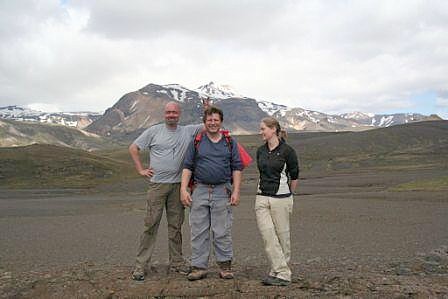
The source of the first sampling target was Tindfjallajökull, a stratovolcano which displays a stunning palette of colours below its glacier capped peak, making an amazing backdrop for fieldwork. The Þórsmörk ignimbrite was erupted from Tindfjallajökull ca. 54.5 ka and has been equated with Ash zone 2 in marine cores from the North Atlantic. The second sampling target was the Sólheimar ignimbrite, the product of a ca. 11.9 ka eruption from Katla, which is reported to be the source of the Vedde ash (a widespread marker horizon in marine and sediment cores from Northern Europe and the North Atlantic). Material was sampled from a section comprising air fall, pyroclastic flow and surge units. Interestingly, the volcanic deposits immediately overlie a fluvial unit also containing angular pumice clasts. These pumices must have been derived locally and deposited shortly before being buried by the Sólheimar products, suggesting that this phase of Katla activity may be more complicated than previously assumed.
The aim of the work is to accurately quantify the major and trace element and isotopic compositions and their ranges in tephra produced during the various stages of the eruption, in order to 1) investigate the magmatic evolution and 2) to provide a comprehensive geochemical dataset with which distal tephras, such as Vedde, can be compared.
Simon Blockley
The main goals of WP-6 are the identification of key tephra in terrestrial sites. To this end we have been sampling and examining key archaeological sites, linked to other work packages, along with important terrestrial archives of past climate change.
Recent archaeological fieldwork highlights include the examination of sediments in North African sites, working with colleagues including Nick Barton (WP-2 coordinator), Abdeljalil Bouzouggar (INSAP Morocco) and Jean-Jacques Hublin (Max Planck). Important archaeological sites, discussed in more detail in the WP-2 section, are now yielding microtephra. We are also examining Lateglacial European sites to aid with WP-3.
As well as working on archaeological sites WP-6 focuses on finding tephra in environmental sequences, where we aim to use tephra to directly correlate environmental changes with archaeological evidence for human change. To this end we are examining lake sites across Europe, such as Soppensse in Switzerland (Blockley et al., 2007), as well as long European loess records, in collaboration with Paul Haeserts (Brussels). One key question we are trying to address at the moment is the reliability of correlation between different distal tephra records. We are sampling and analysing examples of important tephras such as the Vedde Ash, in collaboration with Jan Mangerud (Bjerknes) and Thor Thordarson (Edinburgh). As pictured above, this work has entailed a collaborative trip to Iceland together with RESET colleagues in WP-4.
April 2008
Roman Volcanoes - Colli Albano
Martin Menzies & Emma Tomlinson
Part of the NERC Consortium requires compilation of a masterfile of the geochemistry and geochronology (40Ar/39Ar and/or 14C) of major European tephras (volcanic ash) erupted over the last 10-100,000 years. The major eruptive centres that need to be studied are to be found from the Azores to Turkey and Iceland to Pantelleria. To accomplish this proximal (near or on the volcano) juvenile material must be sampled from pyroclastic fall, flow and surge deposits and studied using XRF, LA-ICPMS and TIMS. Colli Albani, a field target, was visited in April with Guido Giordano (Roma Tre) and Mauro Rosi (Pisa). Guido is involved in the re-mapping of the volcano and has worked on several aspects of the eruptive products and Mauro is co-ordinating the Italian leg of RESET.
The Albano volcano looms over the south of Rome, and although inactive in Roman times the crater lake was a source of major post-volcanic lahars (mudflows). Changes in lake level due to degassing caused water to overtop the crater walls (ca.100m) and debouch down the slopes of the volcano. Archaeological sites indicate that the Romans avoided settling those areas prone to laharic outbursts, and sensibly they took a strategic decision to drain the crater lake to prevent a repetition.

Colli Albano comprises pre and post caldera volcanism. The volcanic hills comprise nested volcanic centres many of which are maars formed by highly explosive eruptions fuelled by water and, in the case of Albani, a lot of carbon dioxide. Phreatomagmatic eruptions produce spectacular base surge beds (i.e., cross-bedded deposits) first recognised during nuclear testing which produced highly destructive base surges. Of course the involvement of water means juvenile (i.e. primary) clasts are “rare as hen’s teeth” (photo 2) . With Guido’s field knowledge we managed to retrieve enough material for preliminary assessment of the proximal chemical variation in the major 69 ka and 36-39 ka old eruptive products. These eruptions at Albano (and elsewhere in Italy) have been dated by 40Ar/39Ar dating methods by Paul Renne (Berkeley Geochronology Laboratory, California) (RESET associate).
An evening train ride up the west coast of Italy took us to Pisa. Prof. Mauro Rosi (director ) co-ordinates the logistics of sampling in Italy which amounts to 85% of the proximal tephra work within RESET and involves twelve collaborators. Over two days we met with Mauro and other staff from Pisa (Gianni Zanchetta, Roberto Scandone) and from Cagliari Sardinia (Raffa Cioni) and returned with splits of samples from well-categorised stratigraphies in Campi Flegrei (Campanian Ignimbrite) and Vesuvius (Pomici di Base, Taurano, Schiava, Verdoline, Codola, Santa Lucia).
July 2007
A research consortium, led by Professor Lowe in the Geography Department of Royal Holloway, University of London, wins £3.4 m to develop a novel approach for assessing how humans may have responded to rapid environmental changes during the recent past. For further information, see the following announcements:
NERC
Earth Sciences RHUL
Geography RHUL
Natural History Museum London






